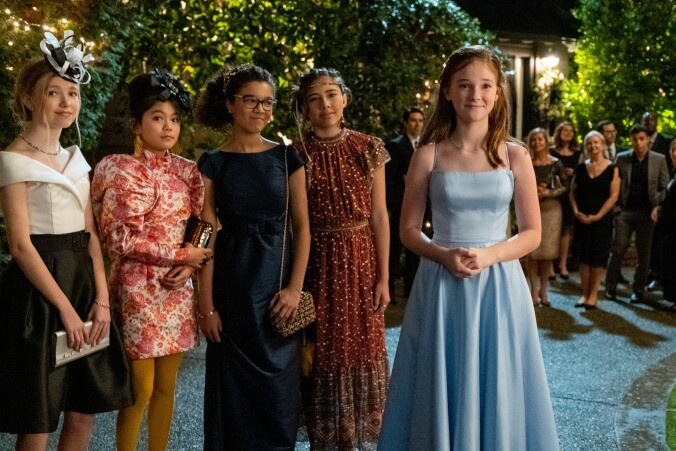Netflix’s The Baby-Sitters Club is captivating family TV

With compelling conflicts, a racially diverse cast, and strong performances from its leads, Netflix’s The Baby-Sitters Club is the best screen adaptation of the book series yet. Fans of Ann M. Martin’s novels, which follow a group of tweens who launch a babysitting business, will be heartened by the new series from showrunner Rachel Shukert and director Lucia Aniello. The TV reboot enhances the source material and is more engrossing than the 1990 HBO show about the sitters—canceled after one season—and 1995 feature film, a box office dud.
Available July 3, the 10 half-hour episodes borrow their titles from the BSC books. The first, “Kristy’s Great Idea,” shows how seventh-grader Kristy Thomas (Sophie Grace) decides to form a babysitters club when her mom (Alicia Silverstone) can’t find childcare. Why, she wonders, should the families of Stoneybrook, Connecticut rely on babysitting apps, when Kristy and her friends can wait by the phone at designated times to fill sitter requests? In addition to president Kristy Thomas, the club includes secretary Mary Anne Spier (Malia Baker), vice president Claudia Kishi (Momona Tamada), and treasurer Stacey McGill (Shay Rudolph). The girls’ personalities are quickly established: While Kristy is hotheaded and controlling, Mary Anne struggles to speak up for herself. Claudia and Stacey bond over boys and fashion, but the former’s style is quirkier than that of the latter, a sophisticated—for a tween, anyway—Manhattanite. Having moved to Stoneybrook from Los Angeles, Dawn Schafer (Xochitl Gomez) joins the club last. She’s laid-back but unafraid to fight for justice, and through her storyline, unapologetic feminist witches enter the picture.
The BSC books were published from 1986 to 2000, so watching the Netflix adaptation might require some suspension of disbelief. For one, latchkey kids ruled the ’80s, when it seemed plausible that parents would entrust middle schoolers with their small children. But today, when helicopter parents make headlines and unaccompanied children walking home from school spark police calls, it’s a stretch to think suburban parents would hire tween sitters for more than the length of a grocery store run. That middle schoolers would use a landline to book appointments also requires a leap of logic. But Claudia is dead-on when describing their translucent phone as “iconic,” as it was a must-have for ’90s kids (the babysitters land one via Etsy). References to Tinder and slang like “basic” place the story in the present, but the show’s home decor and fashion make it look timeless.
Family problems are the source of many of the show’s conflicts. Stacey’s mom, for example, acts ashamed of her daughter’s diabetes. Before her diagnosis, the middle schooler had a seizure that her classmates recorded, circulating the footage online. Nasty rumors spread about why Stacey collapsed, prompting her move to the suburbs. This BSC storyline best uses today’s technology, but it’s heartbreaking to watch a young girl navigate this painful experience without real support. Kristy is also unsure if she can count on her family members. Her type A personality stems from her dad abandoning her and her mom getting engaged to another man. But Kristy’s efforts to control her family and friends only make her feel worse. Fortunately, this young character (a role Grace nails) has enough self-awareness to apologize. She also contends with getting her first period, a topic the sanitized BSC books never broached. Through it all, Kristy’s exceptionally patient mother roots for her.
Claudia’s style has long made her a favorite character. She’s inspired comics, blogs, and the upcoming Netflix documentary The Claudia Kishi Club. With animal-print coats, fruit-shaped earrings, and metallic combat boots, no character’s wardrobe dazzles more than hers, but Claudia’s best look here pays tribute to Hitchock’s The Birds. Her parents, though, want the seventh-grader to be more like her brainiac big sister. Their singular focus on her grades and underdevelopment as characters make them stereotypical “tiger parents.” Claudia’s grandmother Mimi does support her individuality, and when the elderly woman falls ill, Claudia and her (seemingly) non-neurotypical sister bond while discussing Mimi’s traumatic experience in a Japanese American internment camp. It’s one of several instances in which the show excels in dealing with race, though the primarily white or white-passing love interests, along with the narrow depiction of Claudia’s parents, prove there are some areas in which the show falters in its inclusivity.
While Claudia feels like the odd one out in a family of overachievers, Mary Anne is an only child with a widower father who is worrisomely overprotective. The effect of her upbringing reveals itself when Mary Anne realizes she can’t have the slightest confrontation without bursting into tears. Caring for a trans girl who needs medical care helps Mary Anne find her voice and show her dad she’s able to take charge. Though they were both white in the books, Mary Anne is now biracial and Dawn is Latinx. And Jessi Ramsey, an African American dancer and “junior” babysitter, briefly appears with her friend Mallory Pike. (In the books, Jessi and Claudia are the only sitters of color.)
Dawn looks different—and some BSC fans have complained that she’s no longer a California blond—but the character remains the same sensitive girl from the books. In fact, a babysitting client takes advantage of her empathy, expecting Dawn to clean her house, help her rehearse for acting auditions, and watch her kids late at night. Each BSC member is quite capable, but this situation requires a mature adult, and, thankfully, Dawn’s mom intervenes. These tweens might have a knack for business and childcare, but, ultimately, they’re still girls. The Baby-Sitters Club simply gives viewers the privilege of seeing them grow up—if only during the span of middle school. While TV shows for adults routinely feature characters making bad decisions without reflection or remorse, the tweens in this reboot work through their pain and learn from their shortcomings. Witnessing this kind of self-growth is inspirational, whether the viewer is a kid or an adult.